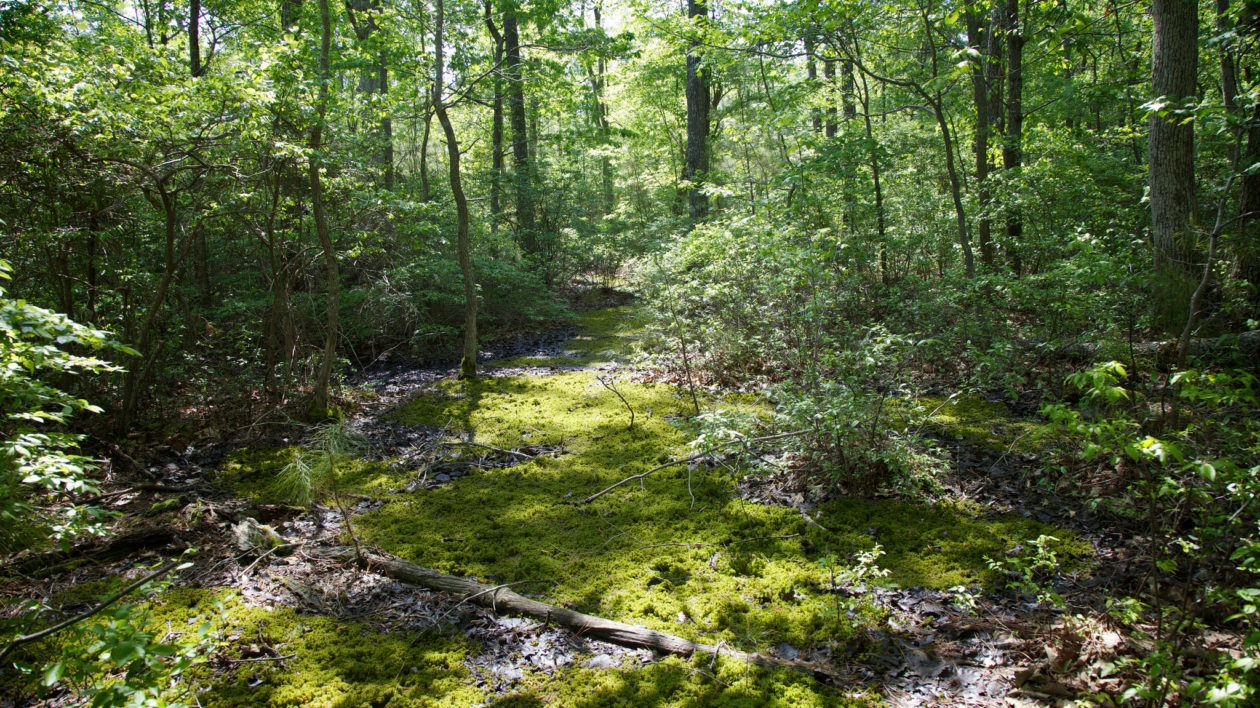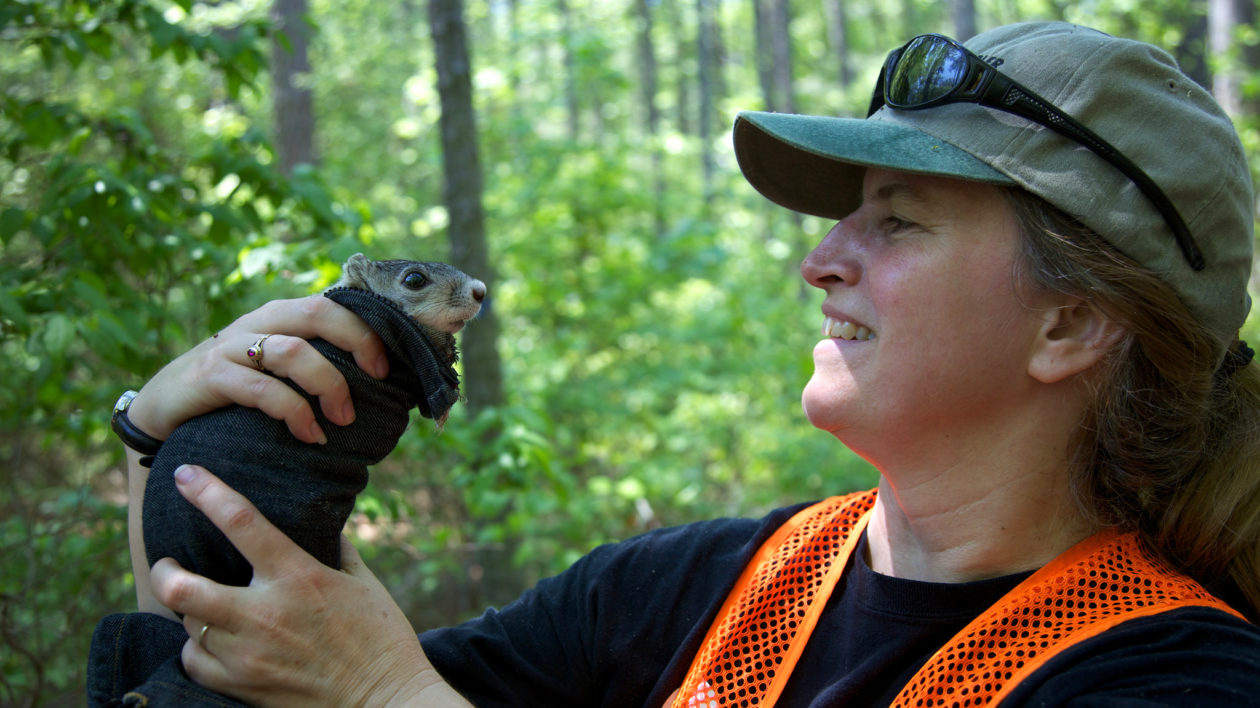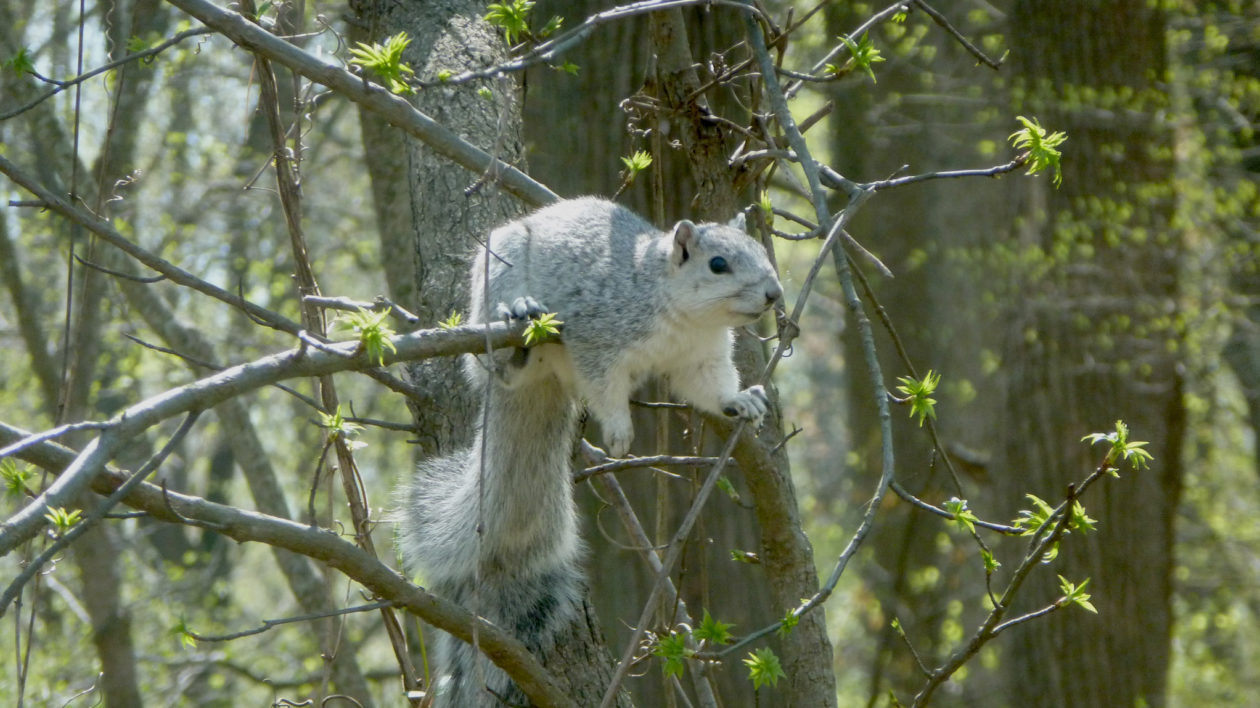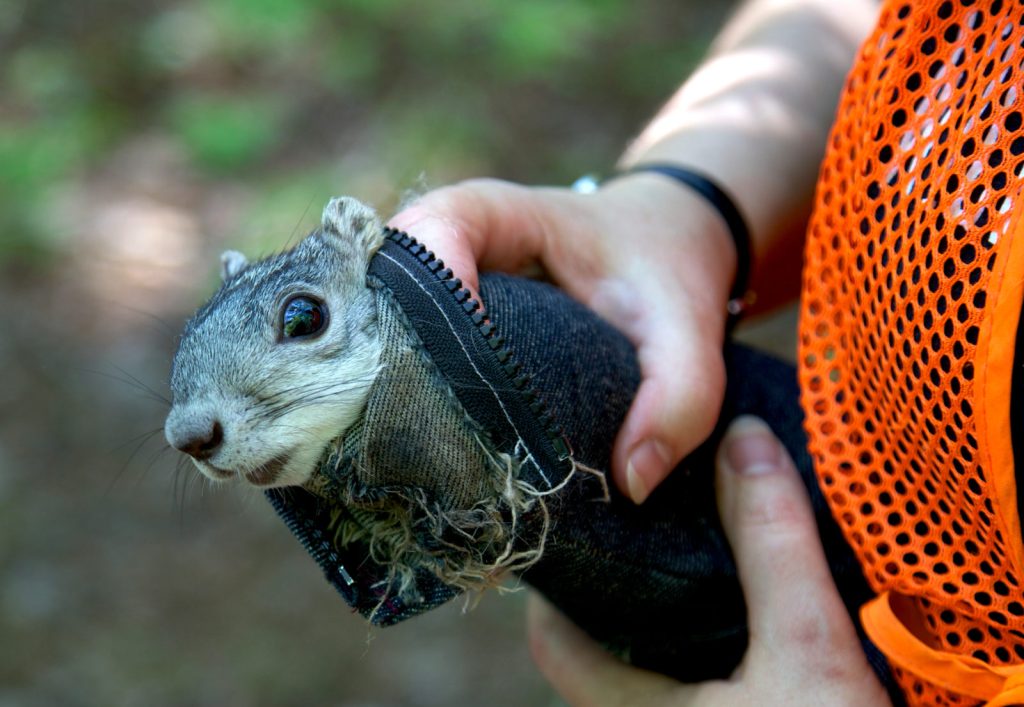Dead squirrels on sun-baked tar contrasted sharply with the beauty of forests and farmland in and around Blackwater National Wildlife Refuge on Maryland’s Eastern Shore.
In two days I counted five road kills — then-endangered Delmarva fox squirrels, the continent’s largest tree squirrel and one of the original 78 listings under the first version of the Endangered Species Act enacted in 1967. All 78 were included in the stronger version of 1973.
Historically, Delmarva fox squirrels had ranged across the whole Delmarva Peninsula and north into parts of Pennsylvania, Virginia and New Jersey. But at time of listing they persisted only in four Maryland counties.
I could discern some of their beauty even in their mangled state. Their dorsal fur was silver and gray, belly fur white, tails full and fluffy. They looked a bit like gray squirrels but at least twice the size and with smaller ears.
Despite a major effort I didn’t encounter a live one in the woods. Delmarva fox squirrels are less fecund than grays and far more secretive and silent, preferring older timber. Wildlife biologists can spend days traversing fully occupied habitat without a sighting.
When Roadkill Is A Good Thing
I can’t recall the exact year I visited Blackwater, but it was shortly after the U.S. Fish and Wildlife Service settled a 1998 lawsuit brought by the environmental community for alleged violation of the Endangered Species Act. Prior to that settlement the agency had pretty much left Delmarva fox squirrel work to the states.
It wasn’t until this past June, when I interviewed recovery-team member Glenn Therres of Maryland DNR’s Wildlife and Heritage Service, that I realized my despair over the road kills had been misplaced. Road kills, if you can believe it, can be a good sign. “They’re not a limiting factor,” Therres explained. “They’re visible, yes. But they’re a function of density and traffic. Blackwater had and has the highest density anywhere.”
In 2015 the Delmarva fox squirrel was removed from protection under the 1973 Endangered Species Act (ESA) because it had expanded from four to ten counties and pushed into parts of Delaware and Virginia. There were thought to be something like 20,000 individuals. Indications are that the population has been increasing since.
This success has been a function of a hunting ban in 1971, innovation, hard work, public cooperation, partner coordination, and luck.
Recovery-team member Dan Rider, of the Maryland DNR’s Forest Service, outlines some of the luck: “The forest has changed. Back in 1960s and 70s there was a plywood plant and a bunch of paper mills drawing wood from the area. This was the age of intense pine management, lots of clearcutting and plantations. There were probably 100,000 acres of very short-rotation forest unavailable to the squirrel.”
Then the plywood plant closed, and the paper industry shifted from clearcutting to thinning. Now pretty much all the forests on the Eastern Shore are managed for saw timber with 60- to 100-year rotations. Trees are getting older, bigger, with full canopy closure — perfect for the fox squirrel. The literature says it’s an interior animal, and it is; but it loves edges, too. It benefits greatly from adjacent corn and bean fields.
“Prior to the lawsuit landowners saw the squirrel as a badge of honor,” declares Rider. “They’d show it off to friends. After settlement [when the feds got involved and when Rider was a private, consulting forester] nobody [claimed they] had fox squirrels. I used to keep records, but after the settlement I didn’t share that information with anyone because I didn’t want landowners getting mad at me. I wouldn’t even tell the landowners because I was afraid some would see the squirrels as a liability and manage against them. Once the squirrel came off the list landowners were raising their hands and saying, ‘Yeah, I’ve got ‘em, had ‘em all along.’ Now I’m seeing landowners actively managing their woods for the squirrel.”
The post-settlement blip notwithstanding, delisting could never have happened without landowner cooperation. Most squirrel habitat is on private land, and from the late 1970s until 1991 landowners allowed the recovery team to translocate squirrels onto their property. Other landowners agreed to let their woods mature to suitable squirrel habitat.
“Back then,” says Therres, “there were no Habitat Conservation Plans (HCPs) [in which a landowner agrees to protect and restore habitat in exchange for immunity from prosecution for inadvertent “take” of a listed species or subspecies]. “And the ESA wasn’t a big hammer. We did everything with handshakes. Landowners were happy to have squirrels, and we allowed them to do whatever they were doing on their property without restriction.”
Nine translocations in Maryland, one in Virginia and one in Delaware succeeded. There were five failures–two in Maryland, and one each in Virginia, Delaware and Pennsylvania.
When HCPs came into vogue the timber industry wanted in. Without an HCP it faced restrictions, red tape, delays and possible prosecution for take.

Managing for Squirrels
Rider and his forester colleagues weren’t biologists, but they knew how to manage forests and saw the results in healthy wildlife populations. They proved that sustainable, thoughtful logging wouldn’t hurt the squirrel. Partnering with the Conservation Fund, Blackwater National Wildlife Refuge and California University of Pennsylvania, they designed a timber-harvest model that left large blocks of contiguous forest in various age classes. And they incorporated it into the state forest plan.
Now, with the remaining market centered on saw timber instead of short-rotation pulp, there’s economic incentive for private landowners and states to manage for squirrels.
As the HCP was being developed the Fish and Wildlife Service came to realize that saw-timber harvest wasn’t hurting to the squirrel population. So the HCP was never implemented.
Still, it proved an important document. “We had a nifty plan put together,” says Rider. “The way I described it was that it would let everyone sleep at night but no one would like it. For example, we pledged in the HCP to never drop the saw-timber-age-class below 50 percent of the total forest. Below that would trigger mitigation. We had about 20 items that had to be met before we could delist.
“The Service knew that if they delisted the squirrel and it slipped, they’d have a document on the shelf they could quickly implement. The timber industry is notoriously inflexible, so we’d point to the other impact groups and say, ‘Gosh guys, if the industry can do this, why can’t you?’ For a document that was never signed or ratified it was very effective.”
In 1984 Maryland gave the squirrels a tremendous boost with the Chesapeake Bay Critical Area Act, which mandated land-use restrictions, additional zoning, extra planning, and protection of endangered-species habitat on all lands within 1,000 feet of that bay and its tidal tributaries.
Then, during 1999 and 2000, through purchase by the state and donation by the Conservation Fund on behalf of the Richard King Mellon Foundation, Maryland acquired 58,000 acres of what it calls “the Chesapeake Forest.” While there had been heavy cutting, these woods are maturing toward squirrel habitat. And since then additional acquisitions have increased the Chesapeake Forest to 73,723 acres.

The Nature Conservancy’s Role
The Nature Conservancy has played a huge role in the recovery effort. In Maryland alone it protects Delmarva fox squirrels on five preserves (three of which are open to the public, see editor’s note below): Robinson Neck/Frank M. Ewing, Choptank Wetlands, Dorchester Pond, Ranck Woods and Nassawango Creek.
And, mostly via conservation easements (in which instead of purchasing land it purchases legally-binding pledges not to harm habitat), it has helped protect 7,700 acres on 10 properties under Maryland’s open-space program and 9,000 acres on 40 properties under the state’s Rural Legacy Program.
For the past 20 years the Conservancy’s Elizabeth Zucker has been handling real estate deals and conservation easements on Maryland’s Eastern Shore. “About any farm with forest I’ve worked on in the Nanticoke River watershed is current or potential squirrel habitat,” she says. “One of the easements I’m proudest of is 1,600 acres of woods owned by the Boy Scouts. We partnered with them, the Fish and Wildlife Service and the state.
“That easement allows timber harvest but in a way that protects the squirrels and other species such as migratory songbirds. Sometimes we provide a bonus — an incentive on top of the easement value under Maryland’s Rural Legacy Program. That includes restrictive language — guidance for foresters to selectively cut for squirrels and migratory birds.”

To Spot a Giant Squirrel
In Maryland the Delmarva fox squirrel is on the Special Concern list. And in Delaware, where it’s known to persist only at the Nanticoke Wildlife Area and Prime Hook National Wildlife Refuge, it’s still listed as state endangered. So intensive management remains a priority.
The most important aspects of that management are more translocations (to connect populations) and post-delisting monitoring. Now monitoring is done with remote cameras. The old method of mark and recapture yielded fewer data and required handling of the animals, always a risk.
“We’ll be bringing in some live-trapped squirrels from Maryland,” says recovery-team member Holly Niederriter of the Delaware Division of Fish and Wildlife. “I’m hoping for next year.”
Recovery-team leader Dr. Cherry Keller of the U.S. Fish and Wildlife Service urges the public to help with post-delisting monitoring. Deer hunters — who spend hours in the woods, often motionless in blinds — are already doing this very effectively.
“I would love for people to know what a unique animal the Delmarva fox squirrel is,” says Keller. “If you’re in the woods long enough, you’ll see them. You have to put in your time; they’re not suburban animals.”
Report sightings to Keller at
cherry_keller@fws.gov
. But make sure they’re credible and
properly identified
.
(Editor’s note: Because of the fragile nature of the habitats they protect, TNC’s Dorchester Pond and Ranck Woods Preserves are not open to the public, but you can read about the work there at the links above. Or find your way to one of the other preserves listed in the sidebar that are open to visitors and definitely worth your time, even if you aren’t lucky enough to spot a Delmarva fox squirrel).




I’m truly saddened to hear once again one more beautiful living breathing animal going extinct. For the love of God someone help.
It is so so encouraging to learn about how people and business worked together to protect and preserve a wonderful wild animal. If only this amazing tale of cooperation would be duplicated over and over by trumps administration our wildlife would not be under such risk of extinction.
Let’s save all our endangered animals so we can enjoy them and learn more about them.???❣️???????
Thank you for this article. I had never heard of this squirrel before. My husband and I feed and water all the “critters” on our 12 acres. Love wildlife ! These little squirrels are absolutely beautiful. Hope they continue to thrive!
Looks like fox squirrels are keystone species, at least in a management sense.
Ted Williams is a great writer but for some reason failed to talk to talk to anyone who is not a TNC or government employee for this article . The squirrels vanished quickly from a new development involved in the lawsuit once it was built in the Md critical area . The critical area law did nothing to protect the squirrels there despite Williams writing “In 1984 Maryland gave the squirrels a tremendous boost with the Chesapeake Bay Critical Area Act, which mandated land-use restrictions, additional zoning, extra planning, and protection of endangered-species habitat on all lands within 1,000 feet of that bay and its tidal tributaries.” Sea level rise threatens some forested areas occupied by DFS and loggers can still clearcut 75% of any forest occupied by the threatened squirrels. There are other important aspects of this issue that went completely unreported and the squirrels are still absent from most of their range (especially in the mid and upper eastern shore )
What a great story about the cute little squirrels….we must protect our wildlife….it is having a tough time existing….
Destroying this planets ecosystems makes Life impossible for all. All species, including humans, will be affected and extinct if we keep this up and for what? The “few” who want to kill our ecosystems forever for their ever increasing, short term monetary gains, is not only selfishly greedy and evil but goes against what our democratic “the many” system is supposed to be. Not the “few”! So, how much longer can a country and world sustain life when those in control don’t care for anything but themselves? Not long, as we are continuing to see thoughout the world.
It’s time to wake up and realize that the majority of those who come from money and/or their interests are to make more money than needed, aren’t the ones who are looking out for the interests of the “many” and shouldn’t be in charge of decisions in regards to the “many”. Of course there are exceptions, I hear, which i have yet to see and have a hard to believing these days. To believe that because one has a lot of money, one is intelligent enough to manage anything well, is Ignorance at its Bliss and has become ” The American Way”!
USA USA, sarcastically speaking!
Several years ago my husband and I were at a meeting at a resort in Florida (maybe Innisbrook?) in the late 80’s. While looking out at the golf course, I saw an animal running on the fairway. I couldn’t see its head, but the back half appeared to be a fox. When I saw the head I realized it was a squirrel! Could this have been a Delmarva fox squirrel?
Thanks for the question. It would not be a Delmarva fox squirrel in Florida. However, there are other fox squirrel subspecies that are also large and impressive. Google Big Cypress fox squirrels and you’ll see a large squirrel with striking coloration. Perhaps that is what you saw?
We need this effort for our coastal “cat” fox squirrels that are equally beautiful in variations of black and white. NC and SC still allow hunting, and at high bag limits (NC).
I think those squirrels & all squirrels are beautiful. I feed and water them, chipmunks, mice & birds everyday. I appreciate everyone’s conservation efforts & am happy to see it paying off. I like to think that I do my part everyday to ensure that these animals aren’t hungry or thirsty, and will continue to thrive for as long as I’m able to do it. I like to make sure that the chipmunks have enough food to get thru the long Maine winter!
Logging our Forests is horrible and disturbing. It is very destructive and wrong. The wild animals need these Forests to call home. They need their natural habitats and environments to live and thrive in. Logging should be banned and become illegal! At least wait many years in between to cut any trees down. . .
Many animals benefit from limited logging. Thick new growth is great cover for these species
hi folks,
we have 400 acres of managed forest in north central wisconsin…..can these little guys be introduced here with a possibility of a positive outcome………I have the time and resources.
Never a good idea to introduce species into new areas. Haven’t we learned from these mistakes before?
Thank you. Squirrels have lone been my favorite animals. I’ve never seen this species before. Thanks to folks like you, maybe one day I will.